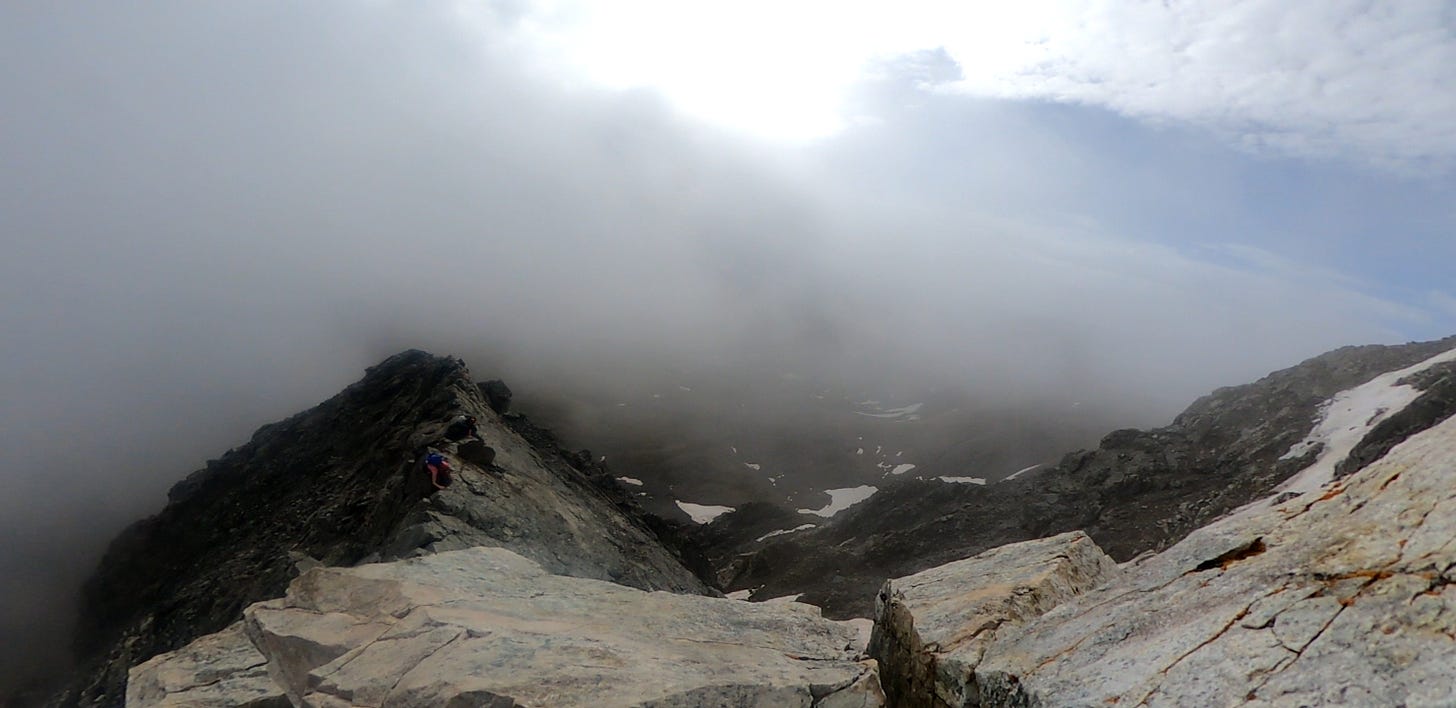How to Climb Kelso Ridge
What one of Colorado's striking and dramatic trails can teach us about preparedness and expectations.
Breaking Away from the Standard Start
Dawn broke over the long ridgeline leading up to Mount Edwards, which made up the eastern wall of the deep valley. The whole place felt like a tucked away Eden, full of gentle snowmelt streams, lush undergrowth, and gorgeous wildflowers.
We couldn’t see the sun itself. But its glow lit up the opposite mountain faces in soft, pink-orange. After stopping to admire the view, we broke from the summit conga line1, turned our backs on the fantastical sight, and walked west in our shadows. My hiking partner and I were bound for the valley’s western wall, and a much less traveled path to the top of Torreys Peak.
Subscriptions are free, support independent writing, and ensure you never miss an edition.
Climbing Kelso: A Breathtaking Challenge for the Sure-Footed
For those looking to experience Torreys Peak without the crowding issues of the main trail, Kelso Ridge is an excellent route — with some big caveats:
It’s much less straightforward than it looks. Familiarize yourself with these route-finding pictures from 14ers.com, so you don’t get lost. More on that later.
Cell service on the ridge is unreliable, which means you need a back-up plan to call for help. I take my Garmin InReach pretty much everywhere I go. As long as you can see the sky, you can send an SOS.
This is a high commitment route. Once you’re up there, backing out can be just as, if not more dangerous than pressing forward.
Exposure is also high; a single fall can be deadly.
This goes for all attempts to climb Grays and Torreys, but the parking situation has changed recently. I lay out those changes here, and it’s worth a read to make sure your car isn’t towed.
Sound like an exciting trip? Share with a friend who may be planning their own adventure!
Respecting the Trail
There are lots of words to describe this trail. One I would never use, is “easy.”
In another post, Lifesaving Advice for Your First Trip to the Mountains, I cover why overconfidence kills. Any hike can be dangerous if you’re not adequately prepared. That’s especially true here.
The beginning of the hike can lull you into a false sense of security. This 30 second montage of the climb shows how quickly the trail decays from a narrow path, to straight-up rock climbing:
Picking up a Stranger Along the Way
You also may have noticed in the video: by the time we reached the summit, the hiking duo became a trio.
About a third of our way up the ridge, my partner and I spotted a lone woman on the wrong side of a gulley, staring up at a steep rock face. We surmised she had gone off the established route, and ran smack into a climb that would have required ropes to complete.
I waved to her. She seemed relieved.
“Are you lost?” I called over.
“Little bit, yeah,” she said.
“You want to come up with us?” I asked.
“Yes, absolutely.”
We guided her to our side of the divide, and she joined us on the much safer main route. She explained she was an experienced hiker, and thought the trail looked simple.

The three of us crossed the famous Knife’s Edge traverse, just as a massive cloud bank rolled in. After that, we followed the steep but straightforward path to the summit.
Rejoining the Other Hikers
“Oh my God, there’s people coming up here!” Someone yelled, a short distance above us. “You guys actually climbed up that?”
Hearing other voices after such a long period of solitude felt jarring. It was like rounding the corner in a desolate forest, only to find yourself at a jam-packed tourist attraction with visitors waiting their turn to snap a souvenir photo.
I’ll admit it was nice getting admiration from other hikers, who couldn’t believe we had taken the ominous-looking scramble to the top.
Taking Inventory After the Climb
When we were halfway back to the trailhead, I started to consider how different this all could have played out for our new friend. This hiker had even more experience than us, with all the proper gear, and still almost became trapped in a dangerous situation.
It just goes to show: the most important safety tools don’t get stowed in your backpack, but your brain. Know the weather, know the route, and know what to do when your plan goes wrong.
I Want to Hear from You
Can you think of a time you were caught unprepared? It doesn’t have to be on a mountaintop. How did you handle it? Did the experience change how you planned for the future? Leave a comment below!
I’ve written about this phenomenon before: on popular hikes, there are often enough people on the trail at any given time to form a continuous line from base to summit.





Being prepared is my middle name.
Ba da da da da DAH! Loved reliving this hike. Sending positive vibes to our Kelso Ridge friend today